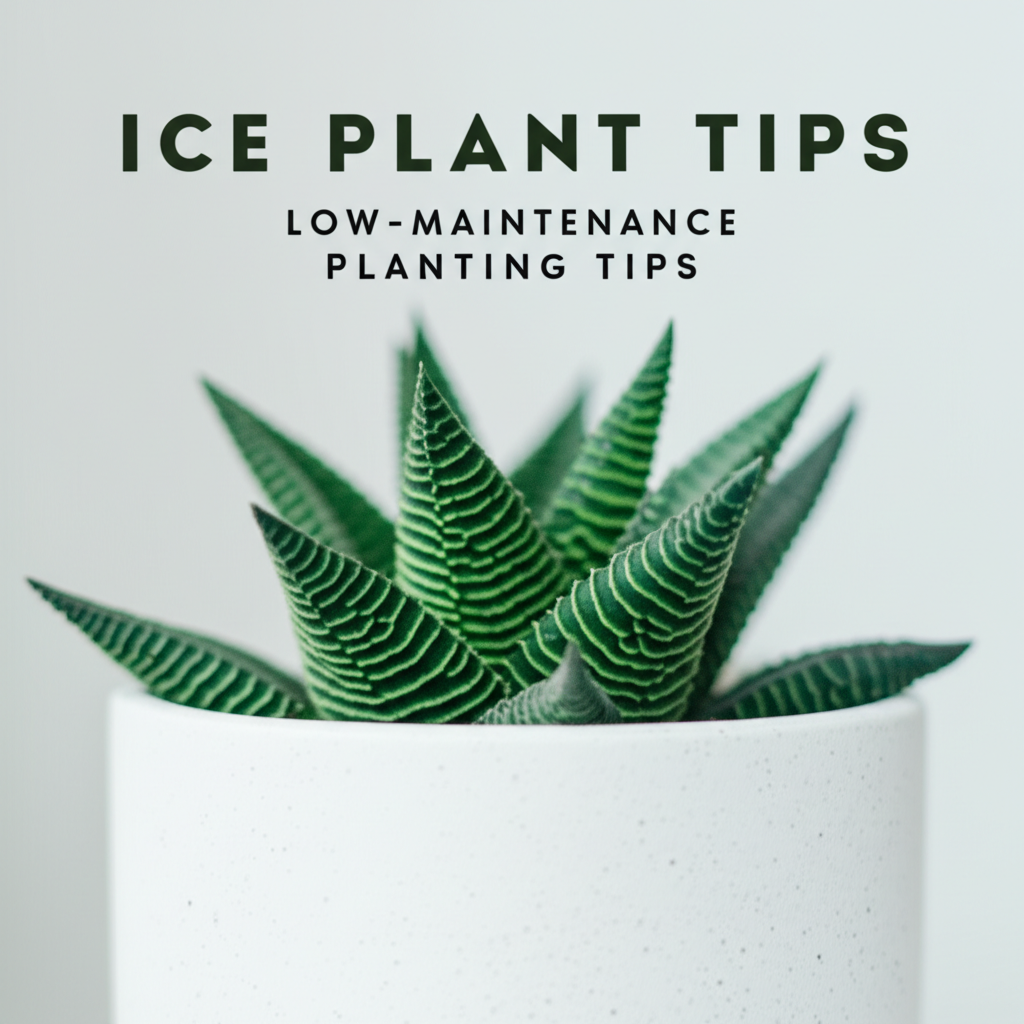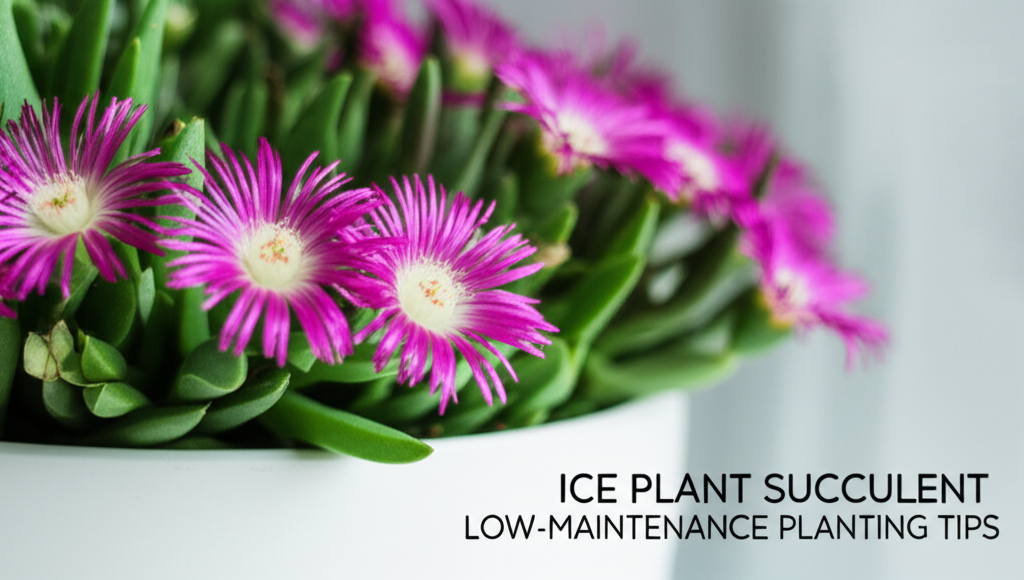The Allure of the Ice Plant Succulent: A Low-Maintenance Marvel
The ice plant succulent, a name that evokes images of glistening frost, is a delightful and remarkably resilient group of plants prized for their vibrant, daisy-like flowers and often striking foliage. These succulents, belonging to the Aizoaceae family, are native to arid regions, particularly South Africa, which explains their inherent ability to thrive with minimal fuss. For gardeners seeking a splash of color and texture without demanding constant attention, the ice plant succulent presents an ideal solution. Their low-maintenance nature makes them perfect for busy individuals, beginner gardeners, or those looking to fill sunny, dry spots with effortless beauty.
This article will delve into the essential low-maintenance planting tips for ice plant succulents, ensuring your garden bursts with their characteristic charm and resilience. We’ll explore their ideal growing conditions, propagation techniques, and how to keep them looking their best with minimal effort.
Understanding the Ice Plant Succulent’s Needs
To achieve low-maintenance success, it’s crucial to understand what the ice plant succulent truly requires. Their native environment has shaped their preferences, and mimicking these conditions is the key to unlocking their full potential with minimal intervention.
Sunlight: The Brighter, The Better
Ice plants are sun-worshippers. They absolutely thrive in full, direct sunlight. For the most prolific blooming and healthiest growth, aim for at least six to eight hours of sunlight per day. In hotter climates, while they appreciate the sun, intense afternoon heat can sometimes scorch their delicate foliage. In such cases, a bit of afternoon shade can be beneficial, but it’s generally less of a concern than providing ample morning and midday sun.
- Ideal Placement: South-facing or west-facing windowsills (indoors) or garden beds in open, sunny locations.
- Signs of Insufficient Light: Leggy growth, pale foliage, and reduced flowering.
Soil: Drainage is Paramount
This is arguably the most critical factor for ice plant succulent success. Just like most succulents, ice plants loathe “wet feet.” They require exceptionally well-draining soil to prevent root rot, their most common nemesis. A sandy, gritty mix is ideal.
- Recommended Soil Mix: A commercial cactus and succulent potting mix is a good starting point. To further enhance drainage, you can amend it with perlite, coarse sand, or pumice in a 1:1 or 2:1 ratio (potting mix to amendment).
- Avoid: Heavy, clay-rich soils that retain too much moisture.
Watering: Less is More
The “low-maintenance” aspect of ice plant succulents truly shines in their watering needs. They are drought-tolerant and prefer to dry out completely between waterings. Overwatering is the fastest way to kill these plants.
- Frequency: Water thoroughly only when the soil is completely dry to the touch, typically every 2-4 weeks, depending on your climate, pot size, and the season. During winter dormancy, watering may be reduced to once a month or even less.
- Method: Water the soil directly, avoiding splashing the leaves, which can encourage fungal issues.
- Key Indicator: The soil moisture meter or the “finger test” (sticking your finger about an inch into the soil) are your best friends.
Temperature: Embracing Warmth
Ice plant succulents are lovers of warmth. They are generally considered annuals in colder climates but can be perennial in USDA hardiness zones 9-11, and sometimes 8 with protection.
- Optimal Temperatures: They thrive in temperatures between 65°F and 80°F (18°C – 27°C).
- Cold Tolerance: Most varieties can tolerate light frost for short periods, but prolonged freezing temperatures will kill them. If you live in a cooler climate, consider growing them in containers that can be brought indoors during winter.
Planting Your Ice Plant Succulent: A Step-by-Step Guide

Planting ice plant succulents is straightforward, focusing primarily on providing the right environment from the start.
Choosing the Right Location
As discussed, sunlight and drainage are the primary considerations.
- In the Ground: Select a spot that receives ample sun and has naturally good drainage or where you can amend the soil easily. Raised beds are excellent for improving drainage.
- In Containers: Choose pots with drainage holes. Terracotta pots are excellent as they allow the soil to breathe and dry out faster than plastic pots.
Preparing the Soil
Whether planting in the ground or in pots, soil preparation is key.
For In-Ground Planting
- Assess Drainage: Dig a hole about 12 inches deep and fill it with water. If the water drains away within a few hours, your drainage is likely adequate. If it sits for a long time, you’ll need to amend the soil.
- Amend the Soil: Mix in generous amounts of coarse sand, perlite, or gravel into the existing soil. Aim for a blend that feels loose and gritty.
- Consider Raised Beds: For extremely poor-draining soils, a raised bed filled with a suitable succulent mix offers the best solution.
For Container Planting
- Select Pots: Ensure pots have drainage holes.
- Use a Succulent Mix: Fill the pots with a well-draining cactus and succulent potting mix, or create your own by combining potting soil with perlite or pumice.
Planting the Ice Plant Succulent
Once your location and soil are ready, planting is simple.
- Gently Remove from Pot: Carefully slide the ice plant succulent out of its nursery pot. If the roots are tightly bound, gently loosen them with your fingers.
- Position the Plant: Place the plant in the prepared hole or pot so that the top of the root ball is level with the surrounding soil surface. Avoid planting too deep or too shallow.
- Backfill and Firm: Fill in the surrounding space with your prepared soil mix, gently firming it around the base of the plant to remove air pockets.
- Initial Watering (Light): After planting, give the plant a light watering. This helps settle the soil around the roots. However, avoid saturating the soil, especially if your soil is already prone to holding moisture.
Key Facts and Comparison: Ice Plant Succulent Varieties
While the general care requirements remain similar, different ice plant succulent varieties offer unique aesthetic qualities and growth habits. Understanding these differences can help you choose the best fit for your low-maintenance garden.
| Variety | Scientific Name | Flower Color | Foliage Description | Growth Habit | Hardiness Zone (Approx.) |
|---|---|---|---|---|---|
| Livingstona Ice Plant | Delosperma cooperi | Vibrant magenta-pink | Fleshy, green leaves | Low-growing, spreading groundcover | 5-10 |
| Golden Dewdrop Ice Plant | Lampranthus spectabilis | Bright yellow to orange | Fleshy, grey-green leaves | Upright, bushy | 9-11 |
| Purple Ice Plant | Delosperma congestum | Bright purple | Small, fleshy, succulent leaves | Compact, mat-forming | 5-10 |
| Red Ice Plant | Delosperma ‘Red’ (Hybrid) | Scarlet red | Small, fleshy, bright green leaves | Spreading groundcover | 5-10 |
| Crystal Dew Ice Plant | Malephora crocea | Yellow to orange, often with red centers | Fleshy, grey-green, triangular leaves | Low-spreading, trailing | 9-11 |
Low-Maintenance Care and Troubleshooting
Once planted, the beauty of ice plant succulents lies in their minimal demands. However, a few basic care practices and awareness of potential issues will ensure your plants flourish.
Watering Wisdom
As emphasized, the golden rule is to let the soil dry out completely.
- Seasonal Adjustments: Water less frequently in cooler months when growth slows or the plant enters dormancy. Increase watering slightly during the active growing season (spring and summer) if conditions are very hot and dry.
- Check the Leaves: Wilting or softening leaves can indicate a need for water. Shrivelled leaves are a stronger indicator. However, mushy, yellowing leaves usually signal overwatering.
Feeding (Fertilizing)
Ice plant succulents are not heavy feeders. In fact, over-fertilizing can lead to weak, leggy growth and fewer flowers.
- Frequency: Fertilize sparingly, perhaps once in the spring at the beginning of the growing season.
- Type of Fertilizer: Use a balanced, water-soluble fertilizer diluted to half strength, or a specialized succulent fertilizer.
Pruning and Deadheading
These tasks are more about tidiness and encouraging more blooms than being strictly essential for the plant’s survival.
- Deadheading: Removing spent flowers (deadheading) can encourage the plant to produce more blooms and prevent seed formation if you don’t wish for self-seeding. Simply pinch or snip off the faded flower stalks.
- Pruning: If the plant becomes leggy or overgrown, you can prune it back. This is best done in spring. Cut back stems to shape the plant or to encourage bushier growth. Cuttings can often be propagated.
Pest and Disease Management
Due to their succulent nature and preference for dry conditions, ice plants are relatively pest and disease resistant.
- Common Issues: The most common problem is root rot due to overwatering.
- Pests: Occasionally, mealybugs or aphids might appear. These can usually be treated by wiping them off with a cotton swab dipped in rubbing alcohol or by spraying with insecticidal soap.
Propagation: Easy as Can Be
One of the joys of low-maintenance plants is their ease of propagation, allowing you to expand your collection or share with friends.
Stem Cuttings
This is the most common and easiest method.
- Take Cuttings: In spring or early summer, snip off healthy stem sections, about 3-4 inches long.
- Allow to Dry: Remove any lower leaves and let the cuttings callous over for a day or two in a dry spot. This prevents rot.
- Plant Cuttings: Insert the calloused ends into a well-draining succulent potting mix.
- Water Sparingly: Mist the soil occasionally, but avoid overwatering.
- Root Development: Roots should develop within a few weeks.
Seed Propagation
While possible, growing from seed is a slower process and may not be as rewarding for the instant gratification of ice plants.
- Sowing Seeds: Sow seeds on the surface of a well-draining succulent mix in spring.
- Keep Moist and Warm: Maintain consistent moisture and warmth.
- Patience: Germination can take several weeks.
Ice Plant Succulent: Pros and Cons for the Low-Maintenance Gardener
Here’s a quick overview of what makes ice plant succulents so appealing, alongside any potential drawbacks for a low-maintenance approach.
| Pros | Cons |
|---|---|
| Drought Tolerance: Requires minimal watering once established. | Root Rot Risk: Highly susceptible to root rot if overwatered or planted in poorly draining soil. |
| Sun Loving: Thrives in full sun, ideal for sunny locations. | Cold Sensitivity: Generally not frost-tolerant and may need winter protection in cooler climates. |
| Vibrant Blooms: Produces profuse, daisy-like flowers in a range of bright colors. | Soil Drainage Critical: Requires exceptionally well-draining soil. |
| Easy Propagation: Can be easily grown from stem cuttings. | Can be Invasive (Rarely): In very specific, ideal conditions, some varieties might spread aggressively, though this is uncommon in most garden settings. |
| Low Maintenance: Generally pest and disease resistant with minimal need for fertilization or complex pruning. | Attracts Pollinators: While a pro for biodiversity, it means a lot of bee activity if planted near seating areas. |
| Attractive Foliage: Fleshy, often colorful leaves add texture even when not in bloom. | Can Appear Sparse in Winter: Some varieties may lose some of their fleshy appearance or color during colder months if not protected. |
Conclusion: Embrace the Effortless Charm
The ice plant succulent is a testament to nature’s ability to create beauty with resilience and simplicity. By adhering to the fundamental principles of ample sunlight, impeccably draining soil, and judicious watering, you can unlock the full, low-maintenance potential of these captivating plants. Their vibrant blooms and interesting foliage offer a rewarding gardening experience that requires surprisingly little effort. Whether you’re a seasoned horticulturist or embarking on your first gardening adventure, the ice plant succulent is a fantastic choice for adding color and texture to your landscape with minimal fuss. Enjoy the effortless charm they bring to your sunny spaces!


